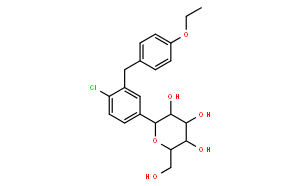| In vitro |
Dapagliflozin is not sensitive to hSGLT1 with a 1200-fold IC50. [1] Dapagliflozin is 32-fold more potent than phlorizin against hSGLT2 but 4-fold less than phlorizin against hSGLT1. Dapagliflozin is highly selective versus GLUT transporters and displays 8–9% inhibition in protein-free buffer at 20 μM and virtually no inhibition in the presence of 4% bovine serum albumin. [2] Dapagliflozin has good permeability across Caco-2 cell membranes and is a substrate for P-glycoprotein (P-gp) but not a significant P-gp inhibitor. Dapagliflozin is stable in rat, dog, monkey, and human serum at 10 μM. Dapagliflozin shows no inhibitory responses or induction to human P450 enzymes. The in vitro metabolic pathways Dapagliflozin are glucuronidation, hydroxylation, and O-deethylation. [3]
|
| In vivo |
Dapagliflozin reduces blood glucose levels by 55% after 0.1 mg/kg oral dose in hyperglycemic streptozotocin (STZ) rats, which is in part to the metabolic stability conferred by the C-glucoside linkage. Dapagliflozin displays a favorable absorption, distribution, metabolism, and excretion (ADME) profile and is orally bioavailable. [1] Dapagliflozin (1 mg/kg) causes significant dose-dependent glucosuria and increase in urine volume in normal rats over 24 hours post-dose. Dapagliflozin induces increase in urine glucose and urine volume excretion at 6 hours post-dose in Zucker diabetic fatty (ZDF) rats. Dapagliflozin lowers fasting and fed glucose levels in ZDF rats even by 2 weeks of treatment, without any marker of renal or liver toxicity. [2] Dapagliflozin significantly reduces the development of hyperglycaemia, with lowered blood glucose. Dapagliflozin could improve the insulin sensitivity, reduce β-cell mass and the development of impaired pancreatic function. [4]
|

 COA
COA MSDS
MSDS HPLC
HPLC NMR
NMR